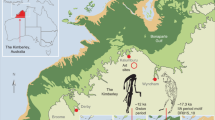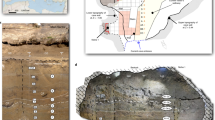Abstract
The view that man did not arrive on the American continent before the last glaciation has been supported by the fact that until now the known and dated archaeological sites have not been of very great antiquity. But now we report radiocarbon dates from a Brazilian site which establish that early man was living in South America at least 32,000 years ago. These new findings come from the large painted rockshelter of Boqueirao do Sitio da Pedra Furada, the walls and the ceiling of which are decorated with a rich set of prehistoric paintings. We have excavated a sequence containing abundant lithic industry and well-structured hearths at all levels. Carbon-14 dates from charcoal establish a continuous chronology indicating human occupation from 6,160±130 to 32,160±100 years BP. A date of 17,000±400 BP, obtained from charcoal found in a level with fragments of a pictograph fallen from the walls, testifies to the antiquity of rupestral art in this region of Brazil.
This is a preview of subscription content, access via your institution
Access options
Subscribe to this journal
Receive 51 print issues and online access
$199.00 per year
only $3.90 per issue
Buy this article
- Purchase on Springer Link
- Instant access to full article PDF
Prices may be subject to local taxes which are calculated during checkout
Similar content being viewed by others
References
Guidon, N. Proc. 10th Congresso UICPYP Mexico, Commission XII, 101–110 (1980); in New Evidence for the Pleistocene Peopling of Americas Orono: Center for Early Man Studies (ed. Shutler, R. Jr) (Sage, Beverly Hills, in the press).
Guidon, N. thesis, Univ. Paris I (1984).
Dillehay, T. D. Scient. Am. 251 (4), 100–109 (1984).
Bryan, A. L. & Beltrao, M. C. Occasional Papers I, 303–305 (Department of Anthropology, University of Alberta, Edmonton, Canada, 1978).
Adovosio, J. M. & Carlisle, R. C. Scient. Am. 250 (5)104–108 (1984).
Bada, J. L. & Helman, P. M. World Archaeol. 7, 160 (1975).
Taylor, R. E. et al. Science 220, 1271–1273 (1983).
Author information
Authors and Affiliations
Rights and permissions
About this article
Cite this article
Guidon, N., Delibrias, G. Carbon-14 dates point to man in the Americas 32,000 years ago. Nature 321, 769–771 (1986). https://doi.org/10.1038/321769a0
Received:
Accepted:
Issue Date:
DOI: https://doi.org/10.1038/321769a0
This article is cited by
-
Morphometric affinities and direct radiocarbon dating of the Toca dos Coqueiros’ skull (Serra da Capivara, Brazil)
Scientific Reports (2022)
-
The Pre-Columbian Peopling and Population Dispersals of South America
Journal of Archaeological Research (2021)
-
Evidence grows that peopling of the Americas began more than 20,000 years ago
Nature (2020)
-
Complex Nature of Hominin Dispersals: Ecogeographical and Climatic Evidence for Pre-Contact Craniofacial Variation
Scientific Reports (2019)
Comments
By submitting a comment you agree to abide by our Terms and Community Guidelines. If you find something abusive or that does not comply with our terms or guidelines please flag it as inappropriate.



